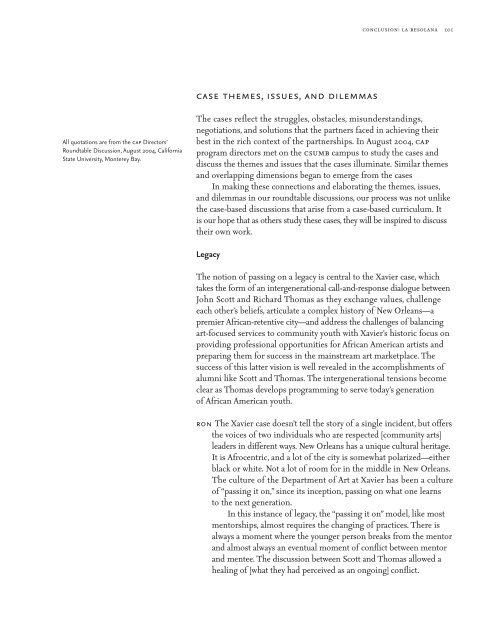art/vision/voice - Maryland Institute College of Art
art/vision/voice - Maryland Institute College of Art
art/vision/voice - Maryland Institute College of Art
You also want an ePaper? Increase the reach of your titles
YUMPU automatically turns print PDFs into web optimized ePapers that Google loves.
All quotations are from the cap Directors’<br />
Roundtable Discussion, August 2004, California<br />
State University, Monterey Bay.<br />
case themes, issues, and dilemmas<br />
The cases reflect the struggles, obstacles, misunderstandings,<br />
negotiations, and solutions that the p<strong>art</strong>ners faced in achieving their<br />
best in the rich context <strong>of</strong> the p<strong>art</strong>nerships. In August 2004, cap<br />
program directors met on the csumb campus to study the cases and<br />
discuss the themes and issues that the cases illuminate. Similar themes<br />
and overlapping dimensions began to emerge from the cases<br />
In making these connections and elaborating the themes, issues,<br />
and dilemmas in our roundtable discussions, our process was not unlike<br />
the case-based discussions that arise from a case-based curriculum. It<br />
is our hope that as others study these cases, they will be inspired to discuss<br />
their own work.<br />
Legacy<br />
conclusion: la resolana 101<br />
The notion <strong>of</strong> passing on a legacy is central to the Xavier case, which<br />
takes the form <strong>of</strong> an intergenerational call-and-response dialogue between<br />
John Scott and Richard Thomas as they exchange values, challenge<br />
each other’s beliefs, <strong>art</strong>iculate a complex history <strong>of</strong> New Orleans—a<br />
premier African-retentive city—and address the challenges <strong>of</strong> balancing<br />
<strong>art</strong>-focused services to community youth with Xavier’s historic focus on<br />
providing pr<strong>of</strong>essional opportunities for African American <strong>art</strong>ists and<br />
preparing them for success in the mainstream <strong>art</strong> marketplace. The<br />
success <strong>of</strong> this latter <strong>vision</strong> is well revealed in the accomplishments <strong>of</strong><br />
alumni like Scott and Thomas. The intergenerational tensions become<br />
clear as Thomas develops programming to serve today’s generation<br />
<strong>of</strong> African American youth.<br />
ron The Xavier case doesn’t tell the story <strong>of</strong> a single incident, but <strong>of</strong>fers<br />
the <strong>voice</strong>s <strong>of</strong> two individuals who are respected [community <strong>art</strong>s]<br />
leaders in different ways. New Orleans has a unique cultural heritage.<br />
It is Afrocentric, and a lot <strong>of</strong> the city is somewhat polarized—either<br />
black or white. Not a lot <strong>of</strong> room for in the middle in New Orleans.<br />
The culture <strong>of</strong> the Dep<strong>art</strong>ment <strong>of</strong> <strong>Art</strong> at Xavier has been a culture<br />
<strong>of</strong> “passing it on,” since its inception, passing on what one learns<br />
to the next generation.<br />
In this instance <strong>of</strong> legacy, the “passing it on” model, like most<br />
mentorships, almost requires the changing <strong>of</strong> practices. There is<br />
always a moment where the younger person breaks from the mentor<br />
and almost always an eventual moment <strong>of</strong> conflict between mentor<br />
and mentee. The discussion between Scott and Thomas allowed a<br />
healing <strong>of</strong> [what they had perceived as an ongoing] conflict.
















